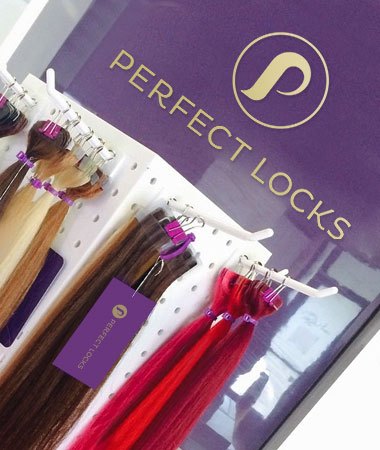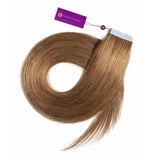Hair extensions can be a game-changer when it comes to transforming your look and boosting your confidence. However, ensuring that the quality of your hair extensions is top-notch is crucial to helping clients achieve a natural and flawless appearance.
Below are a few strategies to effectively manage and uphold the quality of hair extensions, catering to the expectations of your customers and helping you build a reputable and successful brand.
1. Choosing a Trusted Supplier
Selecting a reputable supplier is the first crucial step in managing the quality of hair extensions right from the beginning. It's essential to do your research and read reviews to ensure that the supplier you choose provides high-quality and ethically sourced hair extensions. While it may be tempting to go for the cheapest option, it's best to avoid buying from unverified or questionable sources, as they may offer subpar or even synthetic hair extensions.

2. Synthetic Fiber Quality
If you specialize in synthetic hair extensions, maintaining high-quality synthetic fibers is equally crucial. Premium synthetic materials should closely mimic the look and feel of natural hair. Your customers should not be able to tell the difference between synthetic hair and real human hair when it comes to quality.
3. Quality Control During Manufacturing
Once you have secured the right raw materials, the next critical step is quality control during the manufacturing process. This involves various aspects that need attention to ensure consistency and excellence in your products.
4. Production Equipment
Investing in modern and well-maintained production equipment is essential for maintaining the quality of hair extensions. Regular maintenance and calibration of these machines are necessary to uphold the desired production standards. This not only ensures that the manufacturing process runs smoothly but also significantly impacts the quality of the final product.
5. Skilled Workforce
Your workforce plays an important role in upholding quality standards. Employing skilled and experienced workers who are knowledgeable in the art of hair extension manufacturing is pivotal. Continuously training and enhancing their skills is an investment that directly contributes to the quality of your products.

6. Stringent Quality Checks
At each stage of production, it is vital to implement rigorous quality control procedures. This means regularly inspecting the hair extensions for any defects, such as shedding, color inconsistencies, or tangling. This meticulous approach guarantees that only flawless products make it to the market.

7. Testing for Durability
Conducting comprehensive tests to assess the durability of hair extensions is essential. Factors such as heat resistance, colorfastness, and resistance to wear and tear should be evaluated. These tests ensure that the hair extensions will withstand the rigors of daily use, thereby meeting customer expectations.
8. Ethical and Sustainable Practices
Incorporating ethical and sustainable practices into your production process is increasingly important, given the growing awareness of environmental issues. To improve your brand's image and meet the demands of eco-conscious consumers, use eco-friendly materials and adopt sustainable production practices. This not only benefits the environment but also sets you apart in a competitive market.
9. Packaging and Presentation
The presentation of your products can significantly influence how customers perceive their quality. Designing attractive and secure packaging is essential to protect hair extensions during transportation. Elegant and well-designed packaging also contributes to creating a premium image for your brand. Customers are more likely to perceive your products as high-quality when the packaging reflects that same quality.

10. Clear Product Information
It’s also wise to include comprehensive product information on the packaging. This should cover details like the type of hair or synthetic material used, length, weight, care instructions, and any other relevant information. When customers have access to this information, it helps them make informed decisions, leading to higher satisfaction with the product.
11. Transparency
Transparency is key to building trust with your customers. Be open about the origins and manufacturing process of your hair extensions. Modern consumers appreciate knowing where their products come from and how they are made. Transparency not only fosters trust but also helps differentiate your brand in the market.
12. Quality Control Before Shipping
Before your hair extensions are shipped to customers or retailers, it is crucial to conduct a final quality control check. This ensures that only impeccable products are delivered to the end-users. Any flaws or imperfections that might have been missed earlier can be addressed before the product reaches the customer.
13. Developing a Return and Exchange Policy
No matter how stringent your quality control measures are, occasional mistakes can occur, and not every customer will be completely satisfied with their purchase. Having a well-defined return and exchange policy in place is a critical component of your business. It can help instill trust in your customers, as they know they have options if the product doesn't meet their expectations. A clear and customer-friendly policy is vital for maintaining customer satisfaction and loyalty.
14. Customer Feedback
Listening to customer feedback, both positive and negative, is a valuable source of information for quality improvement. It's essential to have mechanisms in place for gathering and analyzing customer input. This feedback can guide you in making continuous improvements to your products and processes, ensuring that you are always meeting the evolving expectations of your customer base.

15. Quality Assurance Certification
Consider obtaining quality assurance certifications to validate the quality of your hair extensions. These certifications serve as endorsements of your commitment to maintaining high standards. They enhance your brand's reputation and assure customers of the reliability of your products. Many customers look for such certifications when making purchasing decisions, making them an essential component of your quality management strategy.
16. Quality Agreement
Creating a quality agreement with your suppliers can help set clear expectations for the quality of the raw materials they provide. This document outlines the specific quality standards that your suppliers must adhere to. Regular audits of their processes can ensure compliance and identify areas for improvement. This proactive approach strengthens the partnership and ultimately benefits the quality of your hair extensions.
Maintaining the quality of hair extensions from the start of the process is essential for both business owners and suppliers in the beauty industry. By following the tips mentioned above, you can establish a reputation for producing top-tier products. Also, you will be building strong relationships with suppliers and continuously improving based on customer feedback. This will further solidify your position in the market, ensuring the success and sustainability of your hair extension business.

















